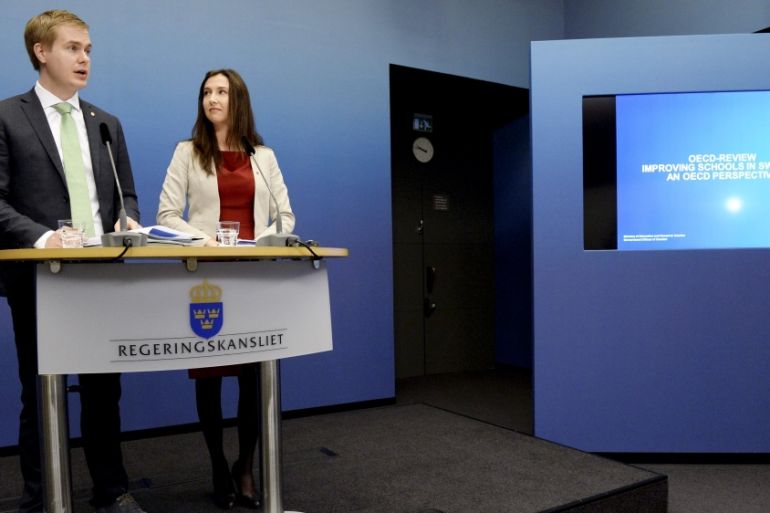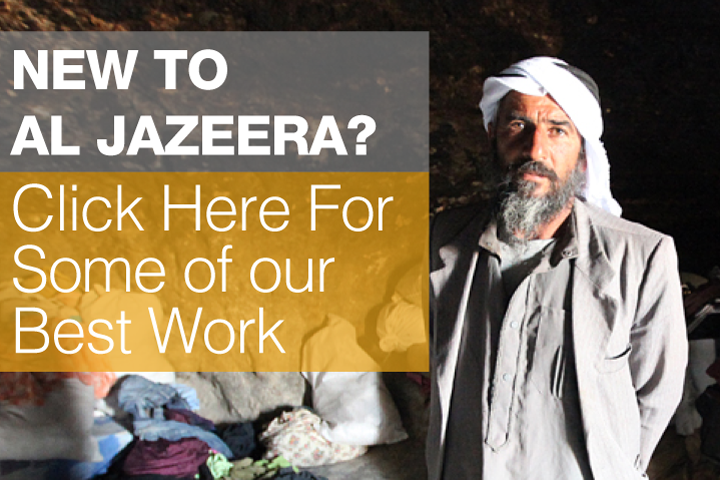Do Sweden’s refugee policies work?
As the government considers new, harsher laws on refugees, we examine the impact of its existing integration policies.

Aida Hadzialic arrived in Sweden as a Bosnian refugee in 1992. She was five years old and her parents had just escaped the Balkan war.
Hadzialic learned Swedish, integrated into her new neighbourhood, graduated from high school and enrolled as a law student at the University of Lund, where she first started to get involved in politics.
Keep reading
list of 4 itemsUK police arrest three over deaths of five people in English Channel
UK passes bill to deport asylum seekers to Rwanda: What’s next?
‘Can’t give them jobs’: Rwandans grapple with fears over UK asylum plan
Then, towards the end of 2014, Stefan Lofven, Sweden’s prime minister, offered her the post of minister for upper secondary school, adult education and training.
‘Swedish from day one’
Hadzialic’s first action as minister was to pass a new law called Swedish from Day One. It is designed to guarantee that all refugees have the chance to learn the country’s language in the least amount of time possible.
“Language is key to integration and gives the refugees a chance to find a job,” she says.
XOV interview: The success story of a refugee in Sweden
Language and job training are central to Sweden’s integration policies.
Olle Burell, Stockholm’s city commissioner for education, says: “At present about 12,000 refugee kids are enrolled in Stockholm’s schools.”
The government has been careful to avoid creating ghetto schools, making sure that the refugee children are integrated into schools across different neighbourhoods.
“It is crucial for the immigrants to feel normal, not to be placed somewhere ‘special’, to be just like everybody else,” Burrell elaborates.

In order to cope with the increased number of students, the government has introduced incentives for retired teachers to return to work and created programmes to train English-speaking refugees to become teachers in order to facilitate the first steps in the difficult process of learning Swedish.
“The Stockholm integration scheme has cost around 10bn krona [$1.2bn],” Burell says. “And we are sure this is a good investment for the future of our community.”
Hamza Ibrahim, who is originally from Somalia and is now the president of a refugee centre for unaccompanied minors in Malmo, Sweden, agrees that “language is crucial to integrate”.
“You cannot really do it without it,” he says. “And even if you speak perfect English it’s not the same because people perceive you as not making an effort, of not wanting to be part of society.
“I know from experience as I came to Sweden as an unaccompanied refugee when I was 16 and started to study the language as hard as I could.”
Alongside the Swedish from Day One programme, the country’s Ministry of Labour has added new vocational training schemes to help the refugees upgrade or learn new skills.
These typically last between 20 and 60 weeks, depending on individual needs, and are intended to ease entry to the job market. Among the courses offered are welding, bus driving, gardening and cleaning.
Of course, this is no guarantee of work, however. Vocational training prepares people for quite specific roles and they are not necessarily ones for which there is a huge demand or a shortfall of available candidates in Sweden.
But when language skills, training and goodwill combine, it can work for some refugees. About a year ago, Adam Sarac hired an Afghan refugee for his sushi restaurant in Malmo. He needed staff and wanted to do something to help refugees.
“I would say Shafiq puts in extra effort to show how grateful he is [for being given an opportunity to work],” Sarac says. “I couldn’t do without him now.”
But not everyone feels so fortunate. Twenty-four-year-old Fardeen speaks calmly, but he’s clearly tired and frustrated. He speaks English but is yet to learn Swedish. His asylum claim has been rejected so he is unable to go to school, access training programmes and, ultimately, get a job. By law, he shouldn’t even be in Sweden.
“I’m underground,” he says. “But the situation is bad, because I cannot help myself and meet other Swedes or feel part of society in any way. Integration, for me, is being able to give something back to the community and I don’t feel like that.”
Are Sweden’s integration policies working?
Sweden is expected to spend roughly two percent of its budget on refugee-related expenses in 2016.
Interactive: Refugees in the Arctic
Analysts from the labour ministry say it is still too early to assess the success of the integration policies implemented at the start of the refugee crisis in 2013.
“There is a lot of talk about the Swedish integration policies, about refugees as a resource for Sweden to train and use in the labour market, but the issue is really not that simple,” says Tino Sanandaji, a researcher at the Stockholm School of Economics. “Studies show how [each] refugee will cost the system more than 70,000 krona [$8,400] a year.
“This does not mean we don’t have to take refugees in, just not as we have been doing up to now if we want to have a real integration in the long-run.”
A poll in early November 2015 found that 41 percent of Swedes thought the country was taking in too many refugees, up from 29 percent in September 2015. Running parallel to this is the rise of the right-wing Sweden Democrats.
The Swedish government is currently discussing a new law that, if implemented in its full form, would drastically reduce the chances of refugees settling, let alone integrating, into Swedish society.
Michael Williams, the vice president of FARR, the Swedish Network of Refugee Support Groups, explains that according to the new law “refugees will obtain a permit for a maximum of three years and the current family reunion rights will also be drastically reduced, a violation of one of the basic rights of the Geneva refugee convention”.
Refugees an asset not a burden
Par Frohnert, a professor of history at the University of Stockholm who specialises in migration movements, says: “It’s possible to see parallels between what is happening today in Sweden and the years of civil wars in former Yugoslavia.
“Larger groups of refugees arrived and the government initially answered with harsher regulations, but in the end kept the borders open. In the same way as today a right-wing, xenophobic party, New Democracy, made it into the parliament, but failed in the next election. The large difference today is that the numbers of refugees is much larger.”
“This new law would simply be unfair,” Pelling tells Al Jazeera. “The country needs to do more for the refugees and [to] facilitate their integration.
Refugees need to be trained and treated as a resource for Sweden, not simply as an economic burden. Over the past years the government voted laws resulting in 140bn krona [$16.9bn] in tax cuts. It could have simply used that money to invest in refugees and in Sweden’s long-term future.”